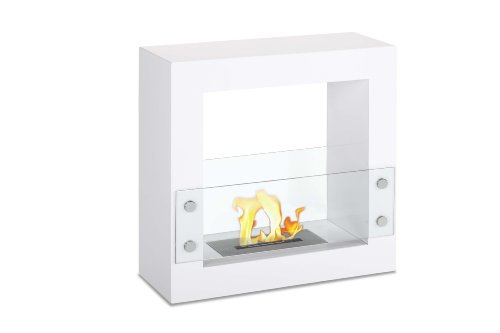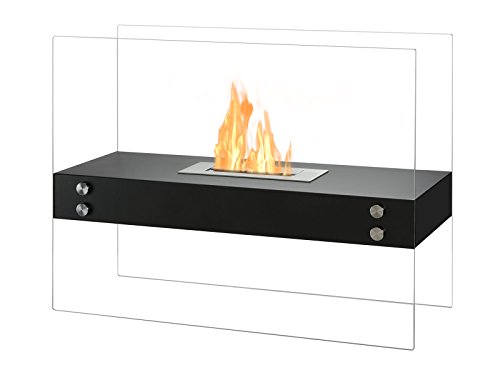Bioethanol Freestanding Stove Tools To Make Your Daily Life Bioethanol…
 Bioethanol Freestanding Stove
Bioethanol Freestanding StoveBioethanol freestanding stoves are a fantastic way to create your dream home. Since they don't require an chimney or flue, installation is simple and won't interfere with your home.
Selecting the best stove is about the right balance between initial investment and long-term fuel costs. Checking specifications like burner reservoir size and the ability to adjust flame height will aid in planning for the cost of fuel.
Freedom to Place
A bioethanol stove offers an elegant, modern alternative to wood-burning fireplaces and wood-burning stoves. They are an excellent choice for many rooms and homes because they don't need a chimney. They burn clean, ethanol-based fuel that doesn't produce harmful fumes or smoke. They are a convenient and flexible heating solution.
A freestanding bioethanol fireplace could be used to create an element of focal point that's elegant and cozy in any room regardless of whether it's an accent piece or feature in your living room or as a warm, intimate backdrop for entertaining guests. The size of the flame can also be altered to fit your preference. A larger flame generates more heat, whereas smaller flames give off more of a romantic glow. The finish and color of the stove may also impact the visual impact. neutral shades such as black or white are a good match for most interior designs and bolder colours can stand out or complement existing furnishings.
Bioethanol stoves can be put in place in many ways, from simple 'plug and play' wall-mounted models that can be fitted in less than an hour to more elaborately designed ceiling or floor-mounted units. Some models have remote controls that let you manage the flames and heat from the comfort of your couch or armchair.
The cost and maintenance of a bioethanol stove are also important aspects to take into consideration. The initial investment might be more expensive than a traditional fire, but the costs over time are usually lower, as the ash and logs don't need to be cleaned or replaced regularly. You should also take into account the amount of bioethanol your stove is consuming per hour, as it can affect how often it will need to be refueled and what the total operating costs will be over the course of time.
If you decide to invest in a bioethanol stove, be sure to speak with a professional before installation. This will ensure that your stove is installed and set properly to ensure safety and performance. They can also advise on how best to maintain your stove, keeping it looking and performing as new for as long as possible.
Aesthetics
Comparing a bioethanol-fueled fire to traditional stoves or fireplaces it is incredibly simple to use. You just need to fill the burner tray with liquid ethanol free standing fireplace and light it. After the flame is lit, you can alter the intensity and height of the flame to suit your preferences. The flame emits a gorgeous warm glow, which instantly transforms the space and makes it feel cozy.
There's also a variety of stylish designs to choose from, which makes them ideal for modern and traditional homes alike. Some of the most popular models feature a curving window which allows you to see the flames clearly, and a fireplace log holder so it appears to be an old-fashioned wood burning stove. Certain models, such as the Oslo by Henley, are more contemporary and have an open-flame look. They are ideal for creating a cozy atmosphere without hassle or maintenance.
Aside from being easy to set up, bioethanol stoves also require very little maintenance. The fact that they do not produce smoke or ash means that you will not be faced with the mess that comes from burning wood. The pure burning of bioethanol freestanding fireplace fuel also means that you don't need to worry about harmful air pollutants.
It's important to remember that all fire places made of bioethanol require adequate ventilation. They use oxygen for combustion, and if you don't allow it to happen your stove may be ablaze or not light. The majority of stoves have safety mechanisms that shut down the flame if the oxygen levels are too low.
It is also essential to ensure that your bioethanol stove is positioned away from any combustible materials such as curtains or soft furniture. Some models come with an automatic shut-off mechanism in the event that they are left unattended for a prolonged period of time, helping to improve security and reduce the chance of damage. In the end, it's recommended to avoid using solid fuels in your bioethanol stove and go for the liquid alternative of ethanol instead. This will not only help keep your home clean but also save money and reduce the environmental impact.
Efficiency
A bioethanol freestanding stove is also referred to as an bio fuel or free standing ethanol fireplaces-fired fireplace, uses clean liquid ethanol fuel to create real flames and heat. Their sleek designs and efficient operation have made them a popular option for modern homes looking to reduce their carbon footprints and enhance the appearance of their living spaces. To ensure a safe, enjoyable experience, it is important that people are aware of the security precautions and the manufacturer's guidelines.
Bioethanol fuel is a renewable resource that can be harvested year after year. It is created by the fermentation of sugars, starches and other starch elements found in plants, such as sugar cane and straw. The fuel is created through a distillation process. When the ethanol liquid is burned, it creates three major by-products : heat and water vapour. These by-products don't harm animals or humans. This makes bioethanol a sustainable alternative to fossil fuels.
bioethanol fireplace freestanding stoves are not harmful since they do not emit smoke or Ash. However, they do require adequate ventilation to work safely. They should only be used in well-ventilated areas and kept away from any flammable materials. Some models of bioethanol stoves come with adjustable burner trays that allow users to control the height of the flames, which can lower the heat output and save on fuel.
The heat output of a bioethanol freestanding stove can differ from model to model, but the vast majority of them have a maximum heat output of 1kW. This is ideal to heat smaller rooms or as a secondary heating source to take the chill off of larger areas.
Bioethanol fireplaces can be a chic and modern heating option for your home. They are also a cost-effective way to save money on the cost of energy. By following the safety precautions and the manufacturer's guidelines you can enjoy the beauty and warmth of a bio fire without the cost of costly maintenance. As more people are conscious of the environmental consequences of their daily activities the demand for products like bioethanol stoves will rise.
Safety
 As a source of heating bioethanol stoves must be in compliance with certain safety standards. They do not produce harmful byproducts like carbon monoxide, and they are safe to use in a room with an open flame. As with all heating solutions however, ventilation is essential to ensure the proper combustion of the appliance and get rid of harmful byproducts. Attention to storage of fuel and installation, as well as maintenance can help prevent potential problems.
As a source of heating bioethanol stoves must be in compliance with certain safety standards. They do not produce harmful byproducts like carbon monoxide, and they are safe to use in a room with an open flame. As with all heating solutions however, ventilation is essential to ensure the proper combustion of the appliance and get rid of harmful byproducts. Attention to storage of fuel and installation, as well as maintenance can help prevent potential problems.A second safety benefit is the fact that, unlike gas fireplaces, standing ethanol fireplace fires do not have fuel lines. This means there is no chance of leaks and accidents involving conduits that are laden with toxic fuel. Furthermore, since the fuel is liquid, if it escapes the limits of the burner once it's in flame, it follows the flame, preventing the spread of a fire that can potentially lead to damage to property or injury to persons.
Lastly, bioethanol fireplaces don't require a chimney and can be utilized in a wide range of homes and rooms including flats, apartments and conservatories. They also produce a significant amount of heat for their size, and do not emit any smoke or ash, making them a perfect alternative to wood and gas fireplaces.
If you are looking for a freestanding bioethanol fireplace there are models in an array of finishes and designs to fit your space and match the aesthetic of your home. You can also search by brand, as well-known and trusted names typically have higher prices but provide a guarantee of high-quality and after-sales support.
The final decision will be determined by the equilibrium between your budget and long-term operating costs. Take into consideration factors like how long it takes to burn each tank (usually five hours) and your fuel consumption rate and your patterns of usage. Estimating accurately will help you determine if the initial investment was worth it and will also give you an idea of monthly or annual fuel expenses. Also, think about any additional equipment you may require, such as an airflow controller or remote.



